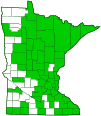hairy vetch
(Vicia villosa ssp. villosa)
Conservation • Weed • Description • Habitat • Ecology • Use • Distribution • Taxonomy
Description |
||
Hairy vetch is a trailing or climbing annual or biennial forb that rises from a 12″ to 36″ long taproot and spreading rhizomes. It often forms colonies. The stems extend 16″ to 40″ and are much branched. They are angled with ridges on the angles and are covered with long, soft, shaggy, spreading hairs. They are weak, reclining on the ground or climbing on adjacent vegetation. The leaves are alternate, 2½″ to 6″ long, and pinnately divided into 5 to 12 pairs of leaflets. Each leaf has a tendril in place of a terminal leaflet and an even total number of leaflets. The tendril has 2 or 3 branches. The main axis of the leaf (rachis) is covered with long, soft, spreading hairs. There are a pair of conspicuous, lance-shaped, ¼″ to ½″ long, leaf-like appendages (stipules) at the base of each leaf stalk. The leaflets are narrowly oblong to lance-shaped linear, short-stalked, ⅜″ to 1 3 ⁄16″ long, and ⅛″ to ¼″ wide. They are alternate to almost opposite. The leaf tips are angled or tapered to a short, sharp, abrupt point at the tip. The upper and lower surfaces are densely hairy. The margins are untoothed. The inflorescence is a dense, spike-like, unbranched cluster (raceme) of 10 to 40 nodding flowers crowded on one side of the central axis. The raceme is on a long stalk rising from a leaf axil. The stalk is covered with long, soft, spreading hairs. Each flower is ¾″ to 1″ long and is attached to the central axis by a short stalk (pedicel). There are 5 green to purple sepals (calyx) fused for most of their length into a bell-shaped, 1 ⁄16″ to ⅛″ long, hairy tube, then separated into 5 teeth. The lower 2 teeth of the calyx are much longer than the upper 3 teeth and are covered with very long, soft, shaggy hairs. The calyx is conspicuously swollen at the base and protrudes beyond the point at which the pedicel is attached. The appearance is of the pedicel attached to the side, not the end, of the calyx. The 5 petals are variable in color, and can be bluish-violet, purple, or rarely white (f. albiflora). They form a butterfly-like corolla, typical of plants in the Pea family. They are organized into a banner petal at the top, two lateral wing petals, and between the wings two petals fused into a keel. The banner is notched at the tip and is usually darker in color than the remaining petals. The fruit is a hairless, ¾″ to 1 3 ⁄16″ long pod containing 2 to 8 seeds. |
||
Height |
||
Trailing or climbing, 12″ to 36″ long |
||
Flower Color |
||
Purple |
||
Similar Species |
||
American vetch (Vicia americana) stems are hairless. The leaflets hairless or sparsely hairy. The flower clusters are much smaller, with 2 to 9 flowers each. Common vetch (Vicia sativa) leaflets are conspicuously squared off and indented at the tip. The flowers appear singly or in pairs on short stalks rising from the leaf axils. Cow vetch (Vicia cracca ssp. cracca) foliage is hairless. The calyx is not swollen, and the pedicel appears to be attached to the end, not the side, of the calyx. |
||
Habitat |
||
Fields, disturbed sites. |
||
Ecology |
||
Flowering |
||
June to August |
||
Pests and Diseases |
||
|
||
Use |
||
|
||
Distribution |
||||
|
Sources |
|||
| 4/30/2023 | ||||
Nativity |
||||
Native to Western Asia and Europe. Introduced and widely naturalized throughout North America. |
||||
Occurrence |
||||
Common |
||||
Taxonomy |
|||
| Kingdom | Plantae (Plants) | ||
| Division | Tracheophyta (Vascular Plants) | ||
| Subdivision | Spermatophytina (Seed Plants) | ||
| Class | Magnoliopsida (Dicots) | ||
Order |
Fabales (Legumes, Milkworts, and Allies) | ||
Family |
Fabaceae (Legumes) | ||
| Subfamily | Faboideae | ||
| Tribe | Fabeae (peas, vetches, and allies) | ||
| Genus | Vicia (vetches) | ||
| Subgenus | Vicilla | ||
| Section | Cracca | ||
| Species | Vicia villosa (hairy vetch) | ||
Subordinate Taxa |
|||
|
|||
Synonyms |
|||
Vicia villosa var. alba Vicia villosa var. villosa |
|||
Common Names |
|||
hairy vetch fodder vetch Russian vetch sand vetch winter vetch woollypod vetch |
|||
Glossary
Axil
The upper angle where the leaf stalk meets the stem.
Calyx
The group of outer floral leaves (sepals) below the petals, occasionally forming a tube.
Corolla
A collective name for all of the petals of a flower.
Pedicel
On plants: the stalk of a single flower in a cluster of flowers. On insects: the second segment of the antennae. On Hymenoptera and Araneae: the narrow stalk connecting the thorax to the abdomen: the preferred term is petiole.
Pinnate
On a compound leaf, having the leaflets arranged on opposite sides of a common stalk. On a bryophyte, having branches evenly arranged on opposite sides of a stem.
Raceme
An unbranched, elongated inflorescence with stalked flowers. The flowers mature from the bottom up.
Rachis
The main axis of a compound leaf, appearing as an extension of the leaf stalk; the main axis of an inflorescence.
Rhizome
A horizontal, usually underground stem. It serves as a reproductive structure, producing roots below and shoots above at the nodes.
Sepal
An outer floral leaf, usually green but sometimes colored, at the base of a flower.
Stipule
A small, leaf-like, scale-like, glandular, or rarely spiny appendage found at the base of a leaf stalk, usually occurring in pairs and usually dropping soon.
Trailing
Prostrate on the ground and creeping, but not rooting at the tip.
Visitor Photos |
|||||
Share your photo of this plant. |
|||||
| This button not working for you? Simply email us at info@MinnesotaSeasons.com. Attach one or more photos and, if you like, a caption. |
|||||
|
|||||
MinnesotaSeasons.com Photos |
|||||
Colony |
|||||
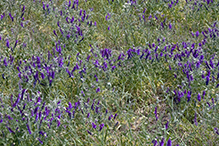 |
|||||
Inflorescence |
|||||
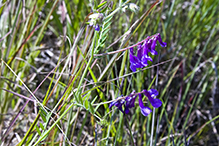 |
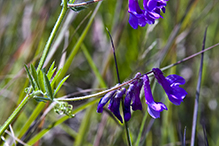 |
||||
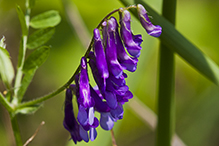 |
|||||
Flowers |
|||||
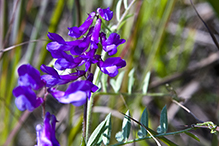 |
|||||
Leaves |
|||||
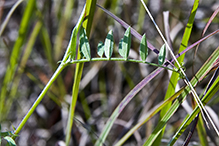 |
|||||

Slideshows |
||

Visitor Videos |
|||
Share your video of this plant. |
|||
| This button not working for you? Simply email us at info@MinnesotaSeasons.com. Attach a video, a YouTube link, or a cloud storage link. |
|||
Other Videos |
|||
| Vicia villosa, excelente forrajera apícola Luis Velazquez |
|||
About
Published on Nov 13, 2012 De la familia de las leguminosas, excelente forrajera, fijadora de nitrógeno. Se la usa mucho en Misiones como cubierta verde en yerbales para contrarrestar el desarrollo de otras hierbas. También es una excelente opción durante la primavera para las abejas. |
|||
| Vicia villosa David Smith |
|||
About
Published on Jun 13, 2014 |
|||
| Hairy Vetch - Cover Crop Solutions CoverCropSolutions |
|||
About
Published on May 18, 2012 CCS Hairy Vetch has been developed by Steve Groff, Pennsylvania no-till farmer and cover crop innovator, as an excellent choice for farms requiring winter hardiness in a cool season legume. |
|||
| Free Nitrogen Fertilizer | Wild Hairy Vetch Greenhorn Gardening |
|||
About
Published on Apr 1, 2013 Here's in a native vetch-type plant that grows in late winter. I see it often around the area. It's great for fixing nitrogen in your soil. It's a weed that does a great service to your garden. |
|||
| Hairy Vetch as Green Manure GreenacresFarmOH |
|||
About
Uploaded on Sep 15, 2009 |
|||

Visitor Sightings |
|||||
Report a sighting of this plant. |
|||||
| This button not working for you? Simply email us at info@MinnesotaSeasons.com. Be sure to include a location. |
|||||
|
|||||
MinnesotaSeasons.com Sightings |
|||||

|
Created: Last Updated: © MinnesotaSeasons.com. All rights reserved. |
